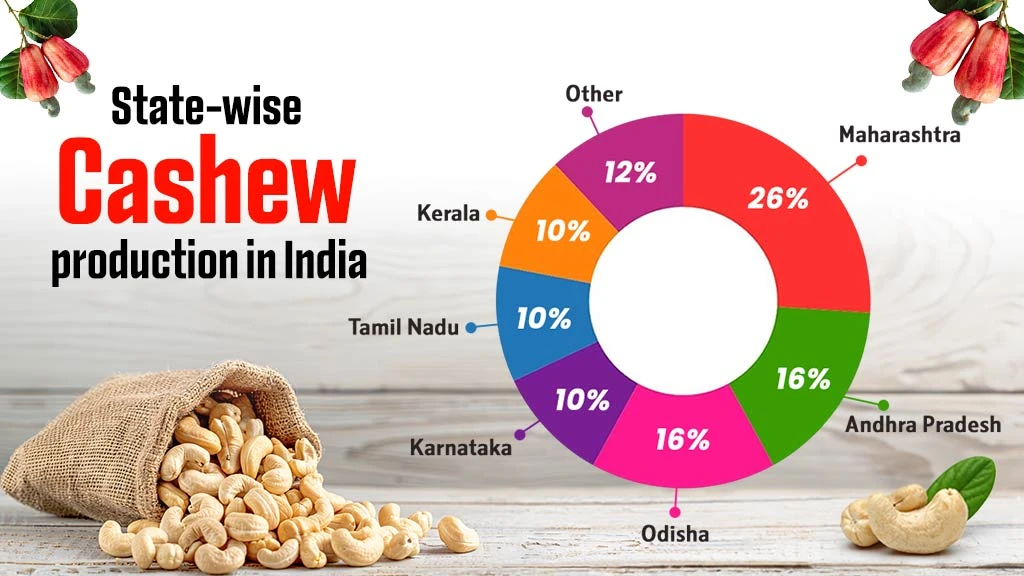Cashew Cultivation in India: From Orchard Establishment to Harvesting

Table of Contents
- Introduction
- Soil and Climate for Cashew Cultivation
- How to Cultivate Cashew Successfully?
- Land Preparation for Establishing Cashew Orchard
- Planting of Cashew Plant
- Fertilizer & Manure Application in Cashew Orchard
- Training & Pruning of Cashew Plants
- Soil & Water Conservation in Cashew Orchards
- Irrigation Management in Cashew Orchard
- Inter-cropping in Cashew Orchards
- Pest & Disease Management
- Harvesting & Yield of Cashew
- What is Cashew Production in India?
Introduction
Cashew is an important plantation crop in India and is known for its golden fruit. It is native to Eastern Brazil and was introduced by the Portuguese in the 16th century to Goa as an afforestation crop. The cashew nut tree is resistant to drought and can be grown even in poor soil conditions. Also, these trees are excellent soil binders, earning the name Gold Mine of Waste Land.
The commercial cultivation of cashews spread from Goa to other states by the late 1960s. From the initial cultivation of cashews for brewing alcohol in Goa (locally known as Fenny, which got GI tag in 2009), today, cashew is cultivated for its fruits, nuts and other by-products across the Peninsular, coastal and North East India.
The cashew cultivation in India helps earn valuable foreign exchange to the tune of INR 4,000 crore as Indian cashews are world famous for their excellent quality. Cashew cultivation also provides livelihood to 15 lakh people, especially women.
Cashew cultivation requires extensive care and maintenance, from the establishment of cashew orchards to training/ pruning to harvesting. Adoption of ultra-high-density method for cashew cultivation can help earn up to INR 5.5 lakhs per acre from the 4th year onwards. Let us see the steps involved in cashew cultivation.
What are the Agro-Climatic Requirements for Cashew Cultivation?
Soil: Well-drained, laterite and sandy soil ideal for good growth and yield
Climate: Warm moist tropical climate| Temperature: 24°C - 28°C| Annual Rainfall: 600 – 4500 mm
Altitude: 700 – 1200 meters
Further, different climatic factors influence the growth, development and production of cashew trees. These are:
- A dry spell during the flowering and fruiting stage ensures a good harvest.
- Cloudy weather, heavy rains, or high temperature causes scorching of flowers and drive & damage of fruits.
How to Cultivate Cashew Successfully?
Land Preparation for Establishing Cashew Orchard
Land preparation is the first stage in planting any crop. So, first clear the land of bushes, shrubs or weeds with the help of a suitable farm implement. It would help if you started preparing the land before pre-monsoon showers in April – May.
After you have cleared the land, the time is to layout the land with the right peg marking for digging pits. The size of the pit would depend upon the method of cultivating the cashew you will be adopting.
- Normal density planting: Square cultivation method is useful. The dimension of the pits measures 60 X 60 X 60 cm, and the spacing between the two pits should be 7 X 7 m.
- High-density planting: In this, a square system is adopted, and the pit size remains the same. However, the spacing shall be 5 X 5 m.
After digging the pit, you must wait to plant cashews. Let the pit be open for 2 – 3 weeks so that it becomes dry and free of any infestations.
Planting of Cashew Plant
Planting cashew plants involves selection of cashew variety, planting method and planting season as given under
Selection of Cashew Variety
Depending upon the regions’ climate and soil, you should select a cashew variety for bumper final yield. More than 40 cashew varieties are grown in India. See the table below:
|
State |
Popular Varieties |
|
Tamil Nadu |
VRI – 1 and VRI -2 |
|
Kerala |
Akshaya, Anagha, Dharasree, Kanaka |
|
Karnataka |
Bhaskara, Nethra Vaman, Chaintamani – 1 |
|
Andhra Pradesh |
BPP -1, BPP -2, BPP – 11 |
|
Maharashtra |
Vengurla 1, Vengurla 4, Vengurla 7 |
|
Goa |
Goa -1 and Goa – 2 |
|
Odisha |
Jagannath, Balabhadra, and Bhubaneshwar – 1 |
|
West Bengal |
Jhagram 1 & 2 |
Procuring the Cashew Saplings
Before you start planting cashews, make sure to procure a healthy cashew sapling from a certified nursery to prevent any future infestations.
Cashew Planting Season
You should start planting the cashew saplings, ideally during the monsoon season in June – August. This is because there is sufficient moisture in the air on both the east and west coasts. However, you can plant the cashews anytime during the year if an irrigation facility is there, but avoid winters.
Planting Material and Planting Method
In order to plant the cashew saplings, you need the following planting materials
- Soft wood grafts of improved and high-yielding varieties
- 15-20 kg compost or FYM, 400-gram rock phosphate and 100-gram Lindane. These need to be mixed with top soil before filling the pit. This will help fight termites.
Cashew is a cross-pollinated crop; thus, a vegetative method of propagation is adopted to cultivate cashews commercially. This method ensures that yield is uniform and fruiting is earlier. Among all, softwood grafting is commercially feasible, practical and highly successful in cashew cultivation.
Softwood grafting method of cultivation consists of four steps. These are:
- Raising of root stock
- Selection of scion
- Grafting
- Aftercare of the graft.
Besides softwood grafting, in-situ grafting (to reduce field mortality) and topworking method (to convert poor yielding cashew trees into desired commercial varieties) are also followed in India.
Fertilizer & Manure Application in Cashew Orchard
The application of manures and fertilizers is critical because they provide essential nutrients to the soil, promoting the growth of plants and advancing the onset of flowering in young trees. You can follow the below-recommended doses of nutrients per plant per year for cashews:
- Farm Yard Manure: 10 – 15 kg
- Nitrogen (N): 500 grams
- Phosphorus Pentoxide (P2O5): 125 grams
- Potassium Oxide (K2O): 125 grams
When Should You Apply the Fertilizers?
You should apply fertilizers and manures immediately after the rain has stopped and the soil has enough moisture available, that is, from the second week of August. Year-wise recommended quantity of doses in grams per plant per year is:
|
Planting Year |
Urea |
Rock Phosphate |
Muriate of Potash |
|
1st |
330 |
125 |
40 |
|
2nd |
660 |
250 |
80 |
|
3rd |
990 |
375 |
120 |
|
4th |
1320 |
500 |
160 |
|
5th and onwards |
1650 |
625 |
200 |
Training & Pruning of Cashew Plants
Managing the canopy of cashew tree is highly critical for maintaining the vigour of the plant and provide proper framework to the plant. This in turn influences the quality of nuts and overall yield. Therefore, you should ensure that training and pruning of plant is done at regular interval from the very beginning.
During the first year of planting, you should frequently remove sprouts that arise from the root stock portion of the cashew graft so that graft grows up to 1 meter height.
Further, you should remove the water shoots, low hanging, crisscross & dry branches. This will help in better flowering and enhanced yield.
Soil & Water Conservation in Cashew Orchards
Cashew is generally cultivated on degraded farmlands, that is why, it experiences severe moisture stress during January to May period affecting the development of flowering and fruits.
To overcome this, you should harvest the post-monsoon and pre-monsoon rainwater along with mulching the soil around the tree with organic matter, particularly coconut husk.
This will help minimize soil erosion and provide essential soil moisture during critical periods.
Irrigation Management in Cashew Orchard
Cashew is cultivated in rainfed regions of India, but proper irrigation can double the yield. The largest area under cashew cultivation is done along the hill slopes of the West Coast where the rainfall distribution and frequency are not uniform, affecting the flowering, fruiting and overall productivity.
Thus, to improve fruit set & fruit retention and double the yield, you should adopt:
- Protective irrigation: 200 litre of water per tree once in a fortnight during the stress period of January – May.
- Drip Irrigation: 60 – 80 litres of water per tree once in four days starting from the initiation of flowering.
Inter-cropping in Cashew Orchards
Cashew trees usually start giving fruits and nuts from 3rd or 4th year onwards. During the period, you can do intercropping to get additional income. You can grow fruits such as papaya & pineapple and vegetables such as turmeric & tapioca along with cashew.
You can even grow Drumstick plant which can serve as a trap crop against the Tea Mosquito Bug (TMB).
Pest & Disease Management
TMB, stem borer, leaf minor, thrips and leaf blossom webber are some of the pests that affect cashew plant. Of these, TMB and stem borer cause economical damage in cashew. They attack the cashew tree during flushing (October – November), flowering (November – December) and fruit setting (January – February) period.
To control the pest, three sprays may be given with the following chemicals:
- Quinalphos (25% EC) - 0.05%
- Carbaryl (50% WP) - 0.01%
- Phosphamidon (85% WSC) - 0.03%
The number of sprays should be restricted to three and the same insecticide should be used for the subsequent sprays.
Harvesting & Yield of Cashew
The cashew tree starts bearing from 3rd year onwards. Good nuts are grey green, smooth and well filled. When the fruits have ripened and fallen, the nuts are separated from the apples, picked and packed in gunny bags. The ideal harvesting time is March – May.
The yield is 1 kg in 3rd to 4th year of planting. The yield increases with the development of canopy. You can expect a yield of above 10 kgs of nuts from 8th – 10th year of planting.
What is Cashew Production in India?

Cashew production in India in 2022-23 was 810 thousand tonnes as compared to 779 thousand tonnes in 2021-22, registering a yearly growth rate of 4%. Its cultivation covers an area of 7 lakh hectares.
At present, cashew cultivation in India is confined to the Peninsular region, coastal areas and some parts of North East India.
Maharashtra, Andhra Pradesh, Odisha, Karnataka and Tamil Nadu are the top 5 cashew producing states. These states together contribute 78% of the total cashew production in the country. See below:


Related Blogs












